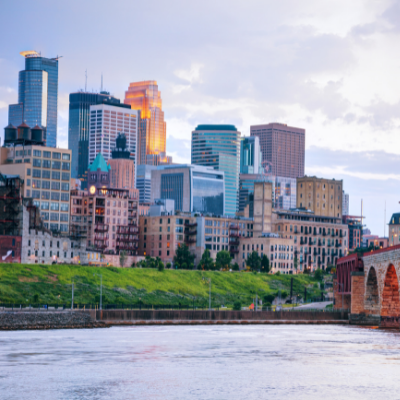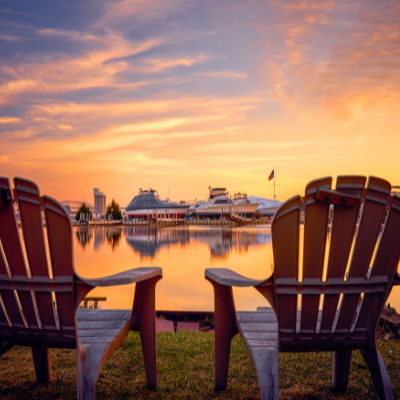Moving to Minnesota Guide: Discover the Gopher State
We created this guide for moving to Minnesota to help those who are in their very early stages of researching where they’d like to move. So, what exactly do you need to know before moving to Minnesota? We complied some of the most important items you should consider when making this big decision. According to 2020 Census data, Minnesota is growing, with a 7.6% increase in population. So, is Minnesota the right state for you to move?

What You Need to Know about Minnesota’s Geography
Minnesota is an upper Midwestern state that shares a border with Lake Superior, the state of Michigan, and Wisconsin to the east, Iowa to the south, and North and South Dakota to the west. The Canadian provinces of Ontario and Manitoba are to the north of the state, and in fact, Minnesota is the northernmost contiguous state in the U.S.!
If you love exploring the outdoors, Minnesota may be the right place for you. In fact, with an area of 86,946 square miles, or 2.25% of the United States, Minnesota can be divided into several distinct geographic and climate regions. Oh, and one of the state’s other nicknames, the Land of a Thousand Lakes, come from the fact that Minnesota has almost 12,000 lakes within its borders!
From the tilted beds of the Middle Precambrian Thomson Formation in Jay Cooke State Park to the beautiful blue waters of Lake Superior, and not to forget the incredible nature that is the Boundary Waters, you’re sure to be inspired by Minnesota’s natural beauty. The variety in the typography is just one of the many things to love about Minnesota.
Minnesota’s highest point is Eagle Mountain, standing at 2,301 ft tall. By comparison, Minnesota’s lowest point is Lake Superior, and that’s only 602 ft! Speaking of high points, much of the state is a gently rolling peneplain, and so Eagle Mountain is actually only 13 miles away from the lowest point in the state!

Moving to Minnesota Guide on the Weather in Minnesota
Minnesota’s unofficial nickname is “Minne-SNOW-ta,” which is fitting since the state experiences temperature extremes characteristic of its continental climate, including freezing cold and snowy winters and hot summers. Even though winter does not officially start until late December, Minnesota usually begins experiencing winter-like conditions in November, sometimes in October.
By the time December and January arrive, Minnesota is fully engulfed in the polar air. Snow is the main form of precipitation, but freezing rain, ice, sleet and sometimes even rain are all possible during the winter months.
Spring is a time of major transition in Minnesota. As winter nears its end, the sun rises higher in the sky and temperatures begin to moderate. As spring moves into the later stages, the chances for snow continue to drop and eventually disappear, south to north. By the time it gets warm enough for severe weather in northern Minnesota, the strength of storm systems have usually started to decrease, which results in fewer severe storms in northern Minnesota compared to the southern part of the state.
During a Minnesota summer, heat and humidity predominate in the south, while warm and less humid conditions are generally present in the north. Daily average summer temperatures in Minnesota range from the low 70s (22 °C) in the south to the mid 60s °F (19 °C) in the north. The summer months of June, July, August, and September account for nearly half of the annual precipitation total across the state of Minnesota. Interestingly, the state’s growing season varies from 90 days in the far northeast to 160 days in the southeast.
The state has dangers associated with blizzards, tornadoes, flooding, and extreme cold temperatures, which should be something to consider if you plan to build a home.

Moving to Minnesota Guide on Getting a Job in the Gopher State
If you’re looking for a place to grow your career, consider moving to Minnesota! According to an article published by the Minnesota Department of Employment and Economic Development, at the time of writing this article, the state of Minnesota has seen a steady job growth rate compared to the rest of the United States. Minnesota continues to add more jobs, resulting in a steady unemployment rate of around 3.3%. Industries showing solid job gains include agriculture, manufacturing, and mining.

What’s the situation on buying alcohol in Minnesota?
Who isn’t curious about how to toast moving to a new state! In Minnesota, no sale of 3.2 beer may be made between 2 a.m. and 8 a.m. on the days of Monday through Saturday, nor between 2 a.m. and Noon on Sunday, with certain exceptions for the airport and sports commission. No sale of intoxicating liquor on-sale may be made between 2 a.m. and 8 a.m. Monday through Saturday or after 2 a.m. on Sundays, except as provided by the Sunday sale law. Of course, you must be older than 21 in order to partake!
The state has an interesting rule for obtaining a liquor license, too! A restaurant, club, bowling center or hotel with at least 30 seats and which holds an on-sale license may sell intoxicating liquor on-sale in conjunction with the sale of food between the hours of 8 a.m. on Sundays and 1 a.m. on Monday after a public hearing, ordinance, and separate Sunday license. The fee for the Sunday license may not exceed $200.

What is there to do in Minnesota?
Hopefully you like hiking and camping! There are over sixty state parks in Minnesota, including Gooseberry Falls and Itasca, that will make every weekend an adventure! Looking for something a little wild? There are also multiple recreation areas, waysides, campsites, and water access sites that might pique your interest, too!
Another choice is to head over to the Twin Cities for culture, food, and fun. A pair of big cities, Minneapolis and St. Paul boast a variety of fun and interesting things to do including the Minneapolis Institute of Art and the Guthrie Theater. However, if you’re like us, we’re sure you’ll agree that outdoor Minnesota is the best. You’ll be in awe each and everything you step outside!

Important State Symbols in Minnesota
The state of Minnesota has over twenty official state symbols; we’ve included a few of our favorites here. The first, and most important, is the state fruit – the Honeycrisp Apple! Minnesota’s agricultural sector supplies many products, but its apple crop sure is sweet!
The state muffin is the blueberry muffin, and the flower is the Pink & White Lady Slipper. Another one of our favorite Minnesota symbols is the state mushroom: the Morel Mushroom. Probably the most unexpected state symbol is the state sport – Ice Hockey!
Q: What is the capital of Minnesota?
A: The capital of Minnesota is Saint Paul. Together Saint Paul and neighboring Minneapolis make up the most populated metro area in Minnesota. The Minneapolis-Saint Paul metropolitan area, known as the Twin Cities, includes seven counties with a combined population of well over two million making it the most populated metropolitan area in Minnesota. If you plan to move to Minnesota, you’ll probably find yourself in one of the Twin Cities!
Q: How do Minnesota’s public schools rank nationally?
A: According to a study by US News, Minnesota public high schools rank 30/50 in a national breakdown tracking state-by-state high school performance. While education quality can vary widely depending on where in the state you live, this report takes the weighted average of the state’s high school performance into consideration.
Q: What kind of taxes can you expect to pay in Minnesota?
A: Minnesota’s income tax is a graduated tax, with four rates: 5.35 percent, 7.05 percent, 7.85 percent, and 9.85 percent. The rates are applied to income brackets that vary by filing status. The state’s combined average sales tax rate consists of its state rate of 6.875 percent and average local rate of 0.58 percent.
Additionally, pensions, including federal pensions, received while a Minnesota resident are taxable by Minnesota regardless of where your pension was earned. Overall, Minnesota ranks in the top ten states for high taxes.
Q: What’s it like to vote in Minnesota?
A: You may vote in Minnesota on election day if you are at least 18 years old on election day, a citizen of the United States, have resided in Minnesota for at least 20 days immediately preceding election day, are not under a court-ordered guardianship in which the right to vote has been revoked, and are not considered legally incompetent to vote as determined by a court.
Voters who have previously registered to vote in Minnesota, either by mail or by registering at the polling place on a previous election day, are required to state their name to the appropriate election judge and sign a polling place roster. The election judge may ask voters to confirm their address and/or date of birth. Voters who have not previously registered to vote using their current Minnesota address may register at the polling place on election day.
Q: What are the rules for switching your driver’s license in Minnesota?
A: If you have an out-of-state driver’s license, you’ll need to transfer it for a Minnesota license within 60 days of moving to the state. You’ll need to complete a Minnesota driver’s license application and provide your social security number and be ready to present one primary and one secondary form of identification. When you present your out-of-state license, it will be invalidated. You’ll also need to provide proof of passing the appropriate testing requirements, including a vision screening, and pay the required fees. You can do all of this at your local Driver & Vehicle Services location!
Q: When do you need to update your car plates in Minnesota?
A: If you have moved from another state to Minnesota, you have 60 days from the day you became a resident of the state to transfer your registration. Plates and stickers are obtained immediately from any of the state’s License Center Locations. Check online to know where to find the nearest one to you and what fees you’ll need to pay!
Q: What’s it like driving in Minnesota?
A: Like most states, the driving conditions in Minnesota are very different in urban and rural areas. Thankfully, Minnesota, in a tie with Utah, ranked at number 40 as the state with the worst drivers in America. Now, that doesn’t mean Minnesota drivers are perfect – there’s just too much to look at out the window of the car!
Q: Does Minnesota have any walkable cities?
A: Of all cities in Minnesota, the best bet for having a walkable lifestyle is going to be in the Twin Cities, but even that’s going to be difficult. The cities have pretty established public transportation, and it is somewhat bikeable. Just watch out for snow!

Is Minnesota the Right State for You to Move?
For those of you looking for outdoor adventure, while still enjoying the creature comforts of city living, Minnesota (and specifically the Twin Cities) may be the right fit for you. The beautiful typography of Minnesota, good schools, and booming economy all lend themselves into making life great in the Gopher State. However, natural disasters like blizzards and high taxes prove that while exceptional, Minnesota isn’t perfect.
We’re curious to hear your thoughts! Does Minnesota fit the bill, or do you need to research other moving guides? Let us know by leaving a comment below?



